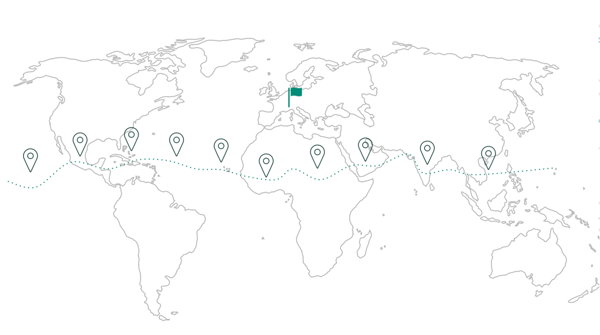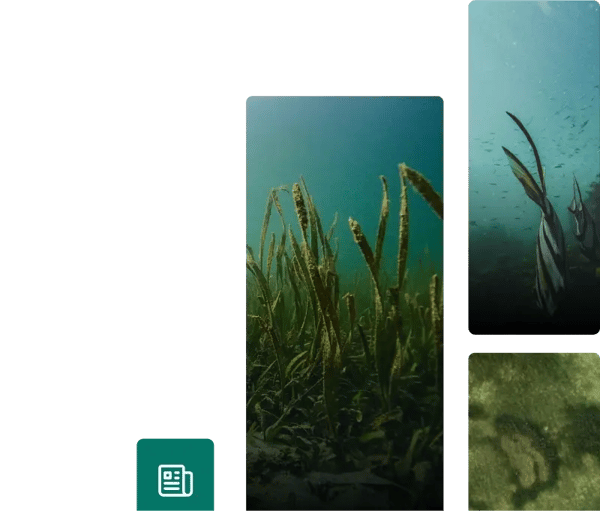EURO AIRSHIP - Solar Airship One
EURO AIRSHIP, a sustainability trailblazer in aviation, has joined forces with ClimateSeed in a strategic partnership to assess it's greenhouse gas emissions related to the groundbreaking airship project.
EURO AIRSHIP, seeks to offer new ways of flying through the development of airships powered by solar panels and fuel cells. The company plans to deploy several models of different sizes and applications. It has called on climateSeed's expertise to measure the greenhouse gas emissions of it's demonstration airship, the same one scheduled for a global circumnavigation, in order to substantiate its climate-related impacts.
With ClimateSeed's expertise in carbon footprint quantification and management, SolarAirship One underscores its commitment to transparency and environmental responsibility.
.webp?width=1000&height=625&name=SolarAirship(1).webp)
Setting the Scene
After 13 years of research, incorporating patented innovations and engineering work by Capgemini Engineering, EURO AIRSHIP is launching the industrialization of an eco-friendly rigid airship.
To promote this innovation, the company is developing a 100% electric demonstrator, representing the future of decarbonized rigid airships. This airship will serve various purposes, including tourism, surveillance, cargo transportation, and humanitarian aid.
However, it is not intended to replace traditional aviation due to its limited capacity, different speed, and specific objectives.
Keys elements
+2060 tCO2
Emissions GHG equivalent
0,027 kgCO2e
per passenger-kilometer
5,000 m2
Of solars films to cover the envelope
Carbon Footprint Report Result
The Last Year, ClimateSeed was Solar Airship's decarbonization partner.
As part of this collaboration, we present to you the results of the GHG assessment for this edition.
EURO AIRSHIP Carbon Footprint Measurement
Initially, ClimateSeed conducted a carbon footprint study across the entire lifecycle of the solar demonstrator.
Graph 1 : The production of the prototype accounts for the majority of greenhouse gas emissions (GHG). This covers the entire value chain, from raw material extraction to airship assembly, including transportation and energy needs at each stage. Aircraft maintenance, especially photovoltaic module replacements, has a significant impact, while the end-of-life phase has a smaller carbon footprint.
Graph 2: Shows that photovoltaic module production is Euro Airship's main greenhouse gas source, contributing to nearly 60% of the solar airship's footprint over a 10-year lifespan with one replacement. It is important to emphasize that the 2060 tCO2e estimate is a preliminary calculation based on current data, which may evolve as design improvements are made.

Comparing GHG Emissions across transportation modes
To assess the carbon impact of airships, comparisons are made with other means of transport. However, these comparisons remain limited, as airships do not serve the same purpose. Its footprint is expressed in terms of intensity per passenger and per kilometer, based on assumptions about its use (occupancy rate, distance traveled).
Solar Airship One : 0,027 kgCO₂e / passenger.km
The calculation of total passenger-kilometers is based on the following hypothesis
Airship capacity: : 46 passagers
Occupancy rate : 80 %
Travel time: : 1 heure
Travel time along the route (excluding takeoff and landing) : 70 %
Travel speed : 60 km/h
For instance: Emission factors associated with aviation can vary by a factor of around 1 to 7 (from 0.130 kgCO2e/pax-km for a short-haul economy without radiative forcing to 0.899 kgCO2e/pax-km for a long-haul first class with radiative forcing, source: DEFRA, 2023) depending on the class considered, the distance flown and whether radiative forcing (condensation trails at high altitudes) is taken into account.
*that this graph only provides a rough estimate, as many factors can influence GHG emissions for a same mode of transportation.
©Datagir

Our Methodology
Carbon accounting categorizes GHG emissions resulting from human activities according to defined boundaries, taking into account time, organization, and function.
The GHG Protocol and the BEGES are widely used for this purpose, primarily for emissions related to organizations, but also for GHG assessments related to events.
ClimateSeed has built its framework using these methodologies as a reference. By adhering to their principles regarding scope, calculations, and categorizations, while considering event-specific data and reporting requirements.
Recommendations
Here are ClimateSeed's recommendations for reducing the carbon footprint of future events
Improve data collection and reduce environmental impact assessment estimates.
Emphasize eco-design and make decisions based on environmental studies.
Broaden their focus beyond carbon by conducting Life Cycle Assessments (LCA), a method to quantify environmental impacts for eco-design, in order to explore other impact categories.
Other perspectives include conducting studies for other airship models, or even assess the carbon footprint of the world tour event.
Solar Airship One Specifics
151
Meters Length
30 m3
Helium expansion volume
5 m²
Of solar films to cover the envelope
Solar Airship's Environmental Benefits
No reliance on fossil fuels
Minimal ground infrastructure required
Silent Flight
Solar Airship One's Ambition
Drawing inspiration from the accomplishments of Solar Impulse's inaugural project, Solar Airship One wants to take on an extraordinary challenge: the first non-stop, fuel-free airhship flight around the world. It aims to promote a new decarbonized air mobility for the future.


Le calcul de l'empreinte carbone du salon Autonomy était une opportunité précieuse pour identifier les sources d'émissions les plus importantes. Le partenariat avec ClimateSeed a permis de mieux comprendre les habitudes des participants et des prestataires, et de collaborer avec eux pour diminuer l’empreinte commune actuelle et future.

Adeline Larroque
Sustainable Event expert of Autonomy
Explore our other
Customer & Project Stories

Ferrari
The sustainable community & innovative initiative project

Autonomy
The largest trade show dedicated to sustainable urban mobility

Agroforestry in Pendjab
Discover our visit in India

ChangeNow
The biggest event organized for the planet

Women's forum
Highlight the link between climate change and gender equality

Mangrove Conservation
& Restoration in San Crisanto

Wool and the Gang
The company with a unique approach to craftsmanship

EuroAirShip
A sustainability trailblazer in aviation

Will Solutions
Sustainable community project in Canada

